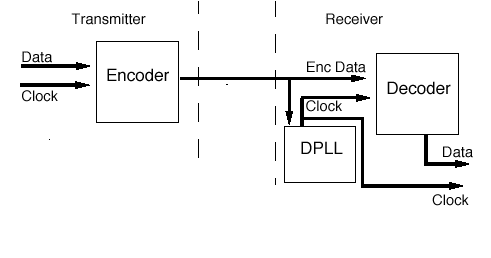- Encoded in the data (e.g. Manchester
Encoding, AMI encoding, HDB3
encoding)

Communication by encoding the clock signal along with data.
The principle difference between the synchronous and asynchronous modes of transmission is that in the synchronous case, the receiver uses a clock which is synchronised to the transmitter clock. The clock may be transferred by:

Communication by encoding the clock signal along with data.
An encoded clock is used in Ethernet. In an encoded system, the receiver can regenerate a copy of the transmitter clock at the receiver using a digital phase locked loop (dpll).
Synchronous transmission has the advantage that the timing information is accurately aligned to the received data, allowing operation at much higher data rates. It also has the advantage that the receiver tracks any clock drift which may arise (for instance due to temperature variation). The penalty is however a more complex interface design, and potentially a more difficult interface to configure (since there are many more interface options).
See also: